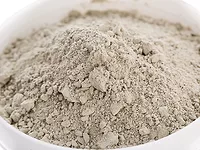Application of Hollow Microspheres in Coatings
Hollow glass polymeric or ceramic microspheres
are used in coatings or composites and exhibit unusual mechanical and
heat-insulation properties.(1) In many countries, heat insulation by
means of coatings is achieved by adding hollow or solid microspheres in
acrylic-based coatings.(2) Many coatings are developed with high
absorbtivity in the visible regime and very low emissivity in the IR regime for
architectural as well as industrial coatings.(3)
Issues like stringent environmental regulations, customer requirements and competitive markets can be tackled with innovative raw material usage and developing new processes. There are many raw materials available that can be called ‘answers awaiting questions’; a good example being microspheres.
These specialty materials are used for many purposes in many diverse industries. Microspheres are innovative raw materials in the coatings industry, and are diverse because both solid and hollow formats are readily available. Solid spheres are most commonly used in reflective traffic paints where the microspheres are used as light reflectors. Hollow microspheres are small, spherical particles ranging in size from 12-300 microns in diameter, and wall thickness up to 0.1 micron. As these microspheres are hollow, the true density is very low, ranging from 0.60 g/cc to as low as 0.025 g/cc. Organic hollow microspheres are mostly composed of polystyrene, polyacrylonitrile or phenolic materials, while inorganic microspheres are glass, ceramic or made from fly ash from thermal power plants.(4)
Solid or hollow glass microspheres are used in various applications in the coatings industry. They are commonly used to improve the performance of epoxy primers, powder coatings, floor applications, aircraft paints and industrial coatings. Hollow spheres are used in thermal insulating coatings for construction and transportation applications, and also for acoustic insulation coatings.(4) Hollow glass microspheres with a density of 0.6 g/cc with a fine particle size distribution can be used in flat wall paint.
Since hollow spheres lower the density of materials, they are added to coatings. If added in coatings, it will atomize better while spraying and it will give less spatter while rolling also sag less once applied. [4]
One of the most important applications microspheres have been developed for is the Space Shuttle program. When the space shuttle re-enters the earth's atmosphere, incredible heat is generated due to increasing air friction. In order to prevent the space shuttle from burning up during re-entry, NASA scientists developed a superior insulating material using Ceramic technology. This technology can now be applied to roofs and sidewalls of buildings, piping, ducts, tanks, various storage devices, refrigerated containers, cold rooms, etc. in order to insulate them from the radiant heat of the sun and the atmosphere by using hollow ceramic spheres.
Stagnant air is a bad conductor of heat because heat is transferred by convection currents. Stagnant air inside hollow spheres acts as an insulator for heat and hence can be used as heat insulating material in coatings. This characteristic of hollow microspheres allows improved thermal and acoustic insulation properties of coatings or composites. Currently, markets taking advantage of this property include fire retardant materials, sensitive acoustic equipment, and roof coatings.
Applications of Hollow Microspheres
Issues like stringent environmental regulations, customer requirements and competitive markets can be tackled with innovative raw material usage and developing new processes. There are many raw materials available that can be called ‘answers awaiting questions’; a good example being microspheres.
These specialty materials are used for many purposes in many diverse industries. Microspheres are innovative raw materials in the coatings industry, and are diverse because both solid and hollow formats are readily available. Solid spheres are most commonly used in reflective traffic paints where the microspheres are used as light reflectors. Hollow microspheres are small, spherical particles ranging in size from 12-300 microns in diameter, and wall thickness up to 0.1 micron. As these microspheres are hollow, the true density is very low, ranging from 0.60 g/cc to as low as 0.025 g/cc. Organic hollow microspheres are mostly composed of polystyrene, polyacrylonitrile or phenolic materials, while inorganic microspheres are glass, ceramic or made from fly ash from thermal power plants.(4)
Glass Microspheres
Glass microspheres give high heat and chemical resistance with density ranges of 0.125 - 0.60 g/cc. The collapse strength depends directly on the wall thickness and density, thus the higher the density, the higher the strength.Solid or hollow glass microspheres are used in various applications in the coatings industry. They are commonly used to improve the performance of epoxy primers, powder coatings, floor applications, aircraft paints and industrial coatings. Hollow spheres are used in thermal insulating coatings for construction and transportation applications, and also for acoustic insulation coatings.(4) Hollow glass microspheres with a density of 0.6 g/cc with a fine particle size distribution can be used in flat wall paint.
Plastic Microspheres
Thermoplastic microspheres are compressible hollow particles with thin shell walls having densities as low as 0.025 g/cc. As resilient plastic materials, these microspheres can deform under stress (during high shear mixing or pumping), and there is very low to no breakage. The compressible nature of plastic can absorb impact, reducing damage caused by stone chips, foot traffic or freeze-thaw cycles.(4)Use in Coatings
Uniform spherical-shaped microspheres have lower surface area then irregular fillers and extender pigments, which means a lower resin demand. Another benefit to the spherical shape is the ability to roll past one another, hence there is minimal impact on viscosity when they are added to a liquid. As coatings are manufactured on weight basis and sold on volume basis, microspheres are used to increase the solid content of a coating, maintaining application and flow properties. Higher-volume solids reduce VOCs, shrinkage and drying time.Since hollow spheres lower the density of materials, they are added to coatings. If added in coatings, it will atomize better while spraying and it will give less spatter while rolling also sag less once applied. [4]
One of the most important applications microspheres have been developed for is the Space Shuttle program. When the space shuttle re-enters the earth's atmosphere, incredible heat is generated due to increasing air friction. In order to prevent the space shuttle from burning up during re-entry, NASA scientists developed a superior insulating material using Ceramic technology. This technology can now be applied to roofs and sidewalls of buildings, piping, ducts, tanks, various storage devices, refrigerated containers, cold rooms, etc. in order to insulate them from the radiant heat of the sun and the atmosphere by using hollow ceramic spheres.
Stagnant air is a bad conductor of heat because heat is transferred by convection currents. Stagnant air inside hollow spheres acts as an insulator for heat and hence can be used as heat insulating material in coatings. This characteristic of hollow microspheres allows improved thermal and acoustic insulation properties of coatings or composites. Currently, markets taking advantage of this property include fire retardant materials, sensitive acoustic equipment, and roof coatings.
Applications of Hollow Microspheres
- All Types of Roofs - Flat or Slopping, made of Concrete, Metal or Asbestos Cement,
- Side Walls of Residential and Commercial Buildings, Hotels and Hospitals, Construction Office,
- Roofs and Sidewalls at Process Control Rooms, Surveillance Towers, Manufacturing Plants and similar constructions and structures
- Piping in Air Conditioning Systems, Steam Pipes, Thermo Fluid Pipes, Boilers
- Exterior of Storage Tanks for Crude Oil, Chemicals, Solvents, Natural and Petroleum Gas, Storage Devices at Petroleum and Petrochemical Industries,
- Grain Silos, Fishing Trawlers, Cold Storage, Refrigerated Trucks and Containers
- Exterior Roofs of Public Transport Vehicles, Railway Passenger Coaches
Limitations
Large particle sizes of microspheres can result in surface texture, meaning gloss reduction. Today, however, fine size hollow glass microspheres are available for coatings requiring higher gloss and thin layer deposition [4]. Microspheres have low density, which means the particles have the tendency to become airborne while being added to the batch. Also for the same reasons, floating or phase separation can occur in the finished mix.Conclusion
Hollow micro spheres (especially glass microspheres) offer improved scrub and burnish properties, gloss, stain resistance, viscosity control, thermal insulation and sound-dampening characteristics. No other conventional additive can match the multiple performance benefits of hollow micro spheres. Their hollow structure, low density and small particle size make them ideal for use as extenders for paint formulations. With particle sizes considerably finer than previously available, hollow micro spheres can be used in thin-film coatings to improve integrity. In the case of glass microspheres, they do not absorb resin, allowing more resin to be available in film forming; the result being a tighter and more uniform film with improved durability [5]. Opaque hollow-sphere polymeric pigments can be added to improve dry hide of coatings, which allows the paint manufacturer to reduce the level of TiO2 in coatings at no loss of performance. [6]Looking for a reprint of this article?
From high-res PDFs to custom plaques, order your copy today!






